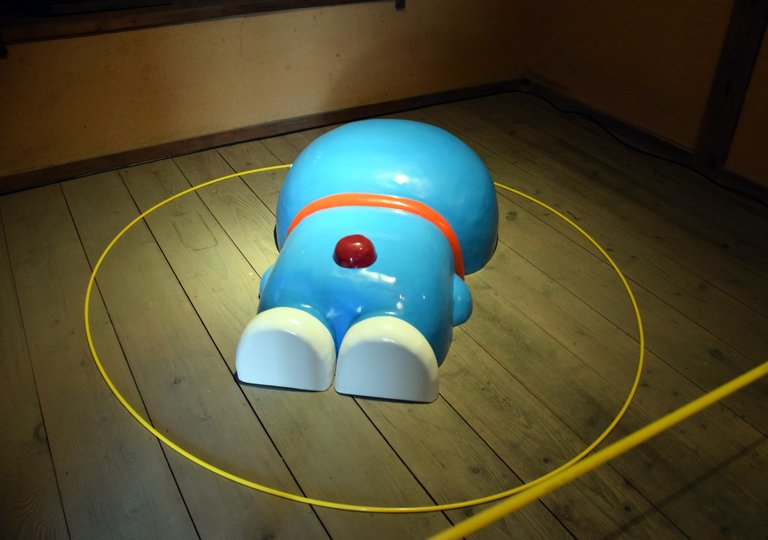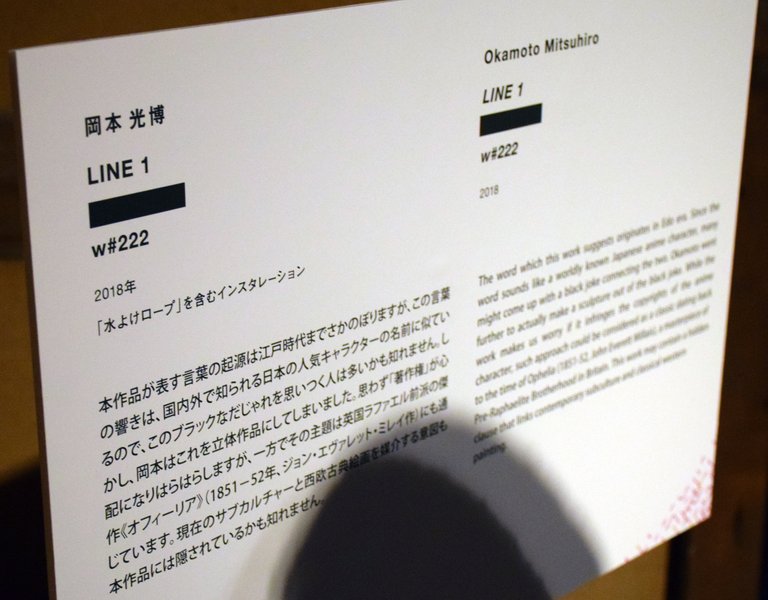Fukuoka Art Event Causes Stir on the Internet for Hiding the Title of an Artwork
A 3-dimensional piece by the artist Mitsuhiro Okamoto was displayed with its title concealed at an art event held at Fukuoka City's castle remains this spring. The hidden title was "Dozaemon." The Special Mission News Crew received a message from a reader that it is probably unheard of for the title of an artwork to be inked out. We began to wonder: what had happened behind the scenes?

Mitsuhiro Okamoto's work, “Dozaemon”(ドザえもん)
The piece in question, "Dozaemon," is one of Mr. Okamoto's representative works. This blue doll, lying flat on its face, resembles a popular Japanese anime character. The name is derived from a word with the same pronunciation, which refers to the body of a drowned person. Mr. Okamoto says that the major theme of his works of art is play-on-words; he uses puns and humor to exhibit this in a manner that at times makes others worry about copyright infringement.
■The incident was triggered by an anonymous caller concerned for the continued disasters occurring across Kyushu
The art event was organized to coincide with the hanami (cherry blossom-viewing) season and was held from March 30 to April 8 as part of Art in Fukuoka Castle, which exhibited the works of 6 artists from Japan as well as other countries. “Dozaemon” was placed inside a turret that had been built in the Edo period (17th to mid-19th centuries), and the name was printed on the flyers that were distributed beforehand.
According to Fukuoka City's Cultural Promotion Section, the event's organization committee, its decision to conceal the artwork name was made due to an anonymous caller who commented that "the word ‘Dozaemon' could be inappropriate." This was on March 13, in the midst of event preparations.
The origin of the word Dozaemon goes back to the Edo era, when drowned bodies were likened to huge sumo wrestlers. The committee contacted all the facilities across Japan that had exhibited “Dozaemon” in the past but did not confirm any similar complaints. Still, in light of the slew of natural disasters that had befallen Kyushu, the committee requested Mr. Okamoto to change the name of his piece.
However, changing the title was problematic for Mr. Okamoto, as it was essential to his work. In the end, Mr. Okamoto considered that "The work should remain in place for the children who saw the flyers," and he had no choice but to hide the title. After consulting the Fukuoka City Museum curator who had invited him to exhibit his art, they decided to cover the lighted box that displayed the title with a piece of cloth. The title printed on the exhibit label, on the other hand, was blackened out to ‘purposefully demonstrate the fact that it was being concealed,'" says Mr. Okamoto.

The title “Dozaemon” on the exhibit label of the work was blacked out (March 31, at the Fukuoka Castle remains in Chuo Ward, Fukuoka City)
■Stifling times: "It is not a good thing to suppress expression"
No explanation was given at the venue regarding the cloth and hidden title. It became a hot topic on the Internet after some media outlets reported on this. Afterwards, the organizing committee received a phone call and an e-mail of complaint that "the work is inappropriate."
In the past, Mr. Okamoto exhibited Rakubei no Osore Ari, which literally translates as Danger of Falling America, for an art event in Okinawa. As the motif of this drawing was a U.S. military plane crash, the local government complained that this work is not compatible with the event's objective of regional revitalization. As a result, it was closed to the public for most of the duration. Mr. Okamoto says that "We shouldn’t suppress expression based on a one-sided perspective. What people need to realize is that art can shake up society because of the very fact that we are living in stifling times."
The representative of the Fukuoka City Museum reflected, "We accepted the citizen's point seriously. We considered ways to exhibit the work of art without using words that require consideration. I am confident that the artist and curator were able to communicate on site and handle the situation."
Torrential rains and other natural disasters have continued in Kyushu, leaving many scars all over the island. However, there is no denying that art conveys strong messages because of its free perspectives. For this occasion, perhaps, we barely reached a middle ground.
The piece “Dozaemon,” whose title had been concealed, ended up becoming a quiz-like exhibition, which must have entertained some visitors. That, too, may be the interesting aspect of art.
「ドザえもん」不適切? 福岡市のアートイベント 市民の指摘で作品名を黒塗り ネットで話題に
この春、福岡市の福岡城跡で開かれたアートイベントで、美術家の岡本光博さん(49)=京都市=の立体作品が題名を伏せて展示された。隠された題名は「ドザえもん」。「美術作品のタイトルを黒塗りするのは前代未聞では」との声が特命取材班に寄せられた。イベントの裏側で何があったのか。

岡本光博さんの作品「ドザえもん」
作品「ドザえもん」は岡本さんの代表作の一つ。人気アニメのキャラクターを想起させる青い人形が、うつぶせに倒れている。「溺死者の遺体」(広辞苑)を意味する「土左衛門(どざえもん)」からもじった。「言葉遊びがメインテーマ」と語る岡本さんは、だじゃれやユーモアを交え、時には著作権侵害が心配になる作風で現代社会を映し出す。
■きっかけは匿名の電話 九州で続発の「災害」考慮
イベントは花見シーズンに合わせ、福岡城跡の各所に国内外の美術家6人の作品を並べる「福岡城まるごとミュージアム」の一環で、3月30日~4月8日に開催。江戸時代に建てられた櫓(やぐら)の中に置かれる形で、事前に配布されたチラシにも「ドザえもん」という題名と写真が載った。
実行委員会事務局の市文化振興課によると、題名を伏せたきっかけは匿名の電話だった。「『ドザえもん』という言葉は不適切では」-。イベントの準備が進む3月13日のことだ。
「土左衛門」の語源は、水死体を巨漢力士に例えた江戸時代にさかのぼる。事務局は過去に「ドザえもん」を展示した全国の施設に問い合わせた。同様の苦情は確認できなかったが、九州で自然災害が続いたことを踏まえ、岡本さんに題名変更を要請したという。
岡本さんの作品にとって題名は重要な要素なので変更は難しい。岡本さんは「チラシを見た子どもたちが見に来るだろうから作品はあった方がいい」と考え、やむなく題名を伏せた。岡本さんを招いた福岡市美術館の学芸員とも相談し、題名が書かれたライトボックスには布を掛け、解説パネルの題名部分は「伏せられている事実をあえて出す」(岡本さん)ため黒塗りにして開幕に間に合わせた。

作品解説では「ドザえもん」というタイトル部分が黒塗りされていた=3月31日、福岡市中央区の福岡城跡
■息苦しい時代「表現を閉ざすのは良くない」
イベント会場では布や黒塗りの理由は説明されていなかった。一部メディアが報じ、インターネットを中心に話題に。その後、事務局には「作品が不適切」といった苦情が電話とメールで1件ずつあったという。
岡本さんは過去に、沖縄県であったアートイベントで米軍機の墜落事故をモチーフに描いた「落米(らくべい)のおそれあり」を出品。地域活性化の趣旨に合わないとして地元自治体の反対を受け、期間中の大半で非公開とされた経験がある。「一方的な見方だけで表現を閉ざすのは良くない。息苦しい時代だからこそ、アートが社会を揺さぶれることも知ってもらいたい」
福岡市美術館の担当者は「市民の指摘を重く受け止めた。配慮すべき言葉を使わずに、どんな展示ができるのか。作家と学芸員がアートの現場でやりとりして対応できた」と振り返る。
ここ数年、九州では豪雨など自然災害が続き、爪痕は地域のあちこちに残る。一方、自由な発想が許されるからこそ、アートは強いメッセージを放つ。今回はぎりぎりのところで着地点を見つけたということか。
題名が黒塗りになった「ドザえもん」は結果的にクイズのような展示になり、楽しんだ来場者もいただろう。それもまたアートの面白さなのかもしれない。
=2018/05/08付 西日本新聞朝刊=
アートとモラルの両立って難しいですね。どうしても主観的な判断になるし。
Good luck :D